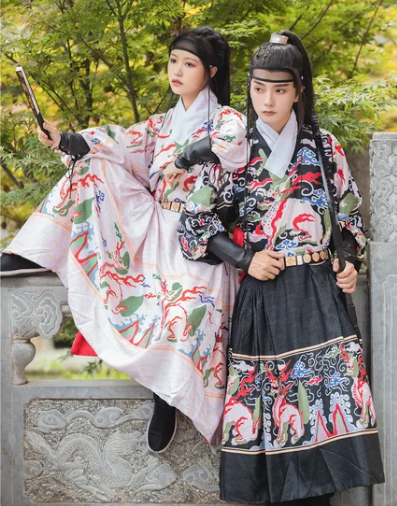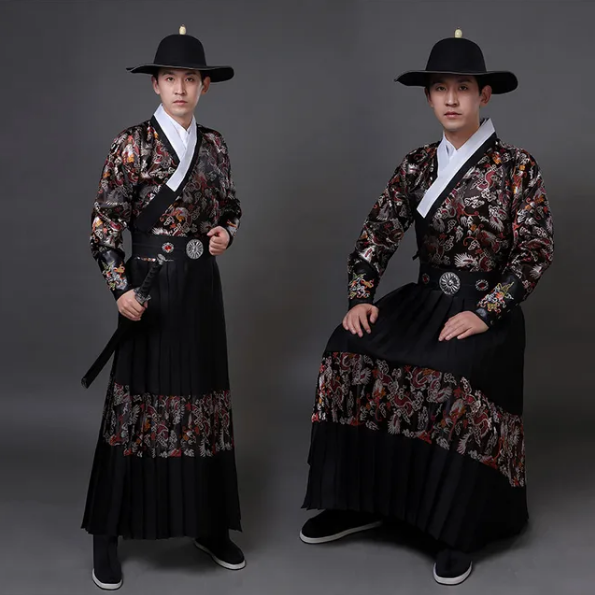Ming Dynasty Flying Fish Suits featured intricate embroidery, ornate embellishments, ergonomic design for mobility, and symbolic motifs reflecting cultural richness.
Ming Dynasty Textile Innovations
Fine Silk Production
In the weaving hubs of Zhejiang and Jiangsu, the Ming Dynasty reached new heights in fine silk production. Utilizing advanced jacquard looms, artisans achieved unparalleled intricacy in textile patterns. Innovations in sericulture techniques contributed to the creation of exquisite silk renowned for its luxurious texture and sheen.
Embroidery Techniques Advancements
Ming Dynasty artisans elevated embroidery to an art form, with intricate needlework, known as “xiucai,” becoming a hallmark. This meticulous craftsmanship adorned clothing and symbolized the epitome of Ming Dynasty textiles’ artistic expression.
Introduction of Brocades and Damasks
Brocades and damasks, characterized by richly woven patterns, gained prominence. Silk threads of various colors were skillfully combined to create elaborate designs, influencing the subsequent development of Ming Dynasty fashion and setting the stage for opulent attire.
Vibrant Use of Colors in Textiles
Ming Dynasty textiles embraced a vibrant palette, incorporating a diverse range of colors, such as reds, blues, and golds, symbolizing prosperity and cultural significance. This rich use of colors extended to Flying Fish Suits, contributing to the overall opulence of the attire.

Fabric Selections and Weaving Techniques
Luxurious Silk Varieties
Zhejiang province introduced Ming Dynasty to various silk types, including Yunjin silk. Woven with gold and silver threads, Yunjin silk added opulence to elite clothing. The intricate weaving techniques of Yunjin silk became integral to the creation of Flying Fish Suits.
Innovative Jacquard Looms
The advent of jacquard looms allowed Ming Dynasty weavers to create complex patterns effortlessly. Controlled by punched cards, these looms influenced the detailed patterns found in Flying Fish Suits, showcasing the meticulous weaving process as a testament to Ming Dynasty’s textile ingenuity.
Influence of Ming Dynasty Textiles on Flying Fish Suits
Embodied Elegance in Flying Fish Suits
Ming Dynasty’s textile mastery left an indelible mark on Flying Fish Suits. The combination of fine silk, elaborate embroidery, and intricate patterns embodied not only the wearer’s status but also the artistic and cultural richness of the era. The influence of Ming Dynasty textiles on these suits became a visual representation of opulence in Ming Dynasty attire.
Tailoring Mastery in Ming Dynasty Fashion
Advanced Construction Methods for Flying Fish Suits
Innovative Pattern Cutting Techniques
Ming Dynasty tailors employed innovative pattern cutting methods to craft Flying Fish Suits. One notable technique involved creating intricate templates using bamboo sticks, ensuring precision in shaping the fabric. This meticulous approach contributed to the suits’ unique and tailored fit.
Integration of Pankou Fastenings
The use of traditional Chinese fastenings, known as Pankou, showcased tailoring ingenuity. These iconic round fasteners, often adorned with elaborate designs, not only served a practical function but also added aesthetic appeal to Flying Fish Suits. Tailors strategically placed Pankou to enhance the overall visual harmony of the attire.
Layered Construction for Fluidity
Tailors adopted a layered construction approach to ensure fluidity in Flying Fish Suits. The garments comprised multiple layers, allowing for graceful movement reminiscent of the fish in flight. This layered design, coupled with precise tailoring, emphasized both functionality and elegance in Ming Dynasty fashion.
Tailoring Expertise Showcased in Ming Dynasty Attire
Emphasis on Silhouette and Proportions
Ming Dynasty tailors paid meticulous attention to silhouette and proportions in attire. Flying Fish Suits, characterized by a sleek and fitted profile, exemplified this expertise. Tailors skillfully manipulated fabric to enhance the wearer’s stature, contributing to the overall grace associated with Ming Dynasty fashion.
Intricate Hand Stitching for Durability
The durability of Ming Dynasty attire was attributed to intricate hand stitching. Tailors employed techniques such as “nanmu,” a traditional Chinese stitching method, to reinforce seams and edges. This attention to detail not only ensured the longevity of Flying Fish Suits but also highlighted the craftsmanship embedded in Ming Dynasty tailoring.
Customization to Reflect Social Status
Tailoring expertise was not only about technique but also about reflecting social status. Ming Dynasty tailors customized Flying Fish Suits based on an individual’s rank and societal standing. The incorporation of specific design elements and embellishments conveyed a subtle yet significant message about the wearer’s place in the social hierarchy.
Impact of Tailoring Mastery on Ming Dynasty Fashion
Enduring Legacy in Contemporary Fashion
The tailoring mastery of Ming Dynasty fashion continues to influence contemporary design. Elements such as precision pattern cutting, traditional fastenings, and layered construction can be observed in modern interpretations of Flying Fish Suits. Ming Dynasty’s tailoring legacy remains a source of inspiration in the ever-evolving world of fashion.
Acknowledgment in Fashion History
Ming Dynasty tailoring has earned its place in the annals of fashion history. The fusion of technical expertise and artistic sensibility, exemplified in Flying Fish Suits, remains a testament to the era’s tailoring mastery. Acknowledging this historical influence enriches our understanding of the intricate relationship between craftsmanship and style.
Distinctive Elements of Flying Fish Suit Designs
Ornate Embellishments and Decorative Patterns
Intricate Embroidery Techniques
Ming Dynasty’s Flying Fish Suits were adorned with intricate embroidery, showcasing the artistry of “xiucai.” The stitches formed elaborate patterns inspired by nature, often resembling waves and aquatic motifs. This meticulous embellishment added a layer of opulence to the attire, contributing to its distinctive appeal.
Gold and Silver Threadwork
Embellishments went beyond conventional threads, as Ming Dynasty artisans incorporated gold and silver threads into the embroidery. This not only elevated the visual richness of Flying Fish Suits but also emphasized the wearer’s social status. The reflective qualities of these precious metals added a dynamic element to the overall design.
Pankou Fastening as Decorative Elements
The iconic Pankou fastenings, beyond their functional role, served as decorative elements on Flying Fish Suits. Craftsmen adorned these round fasteners with symbols and motifs, further enhancing the aesthetic allure of the attire. Pankou became an integral part of the overall ornate design, representing a fusion of functionality and artistry.

Symbolic Motifs Interwoven into Flying Fish Suit Aesthetics
Dragon and Phoenix Symbolism
Flying Fish Suits often featured symbolic motifs, with dragons and phoenixes being prevalent. Dragons symbolized power and prosperity, while phoenixes represented grace and beauty. The interplay of these motifs on the attire conveyed not just ornamental beauty but also deeper cultural meanings associated with good fortune and auspiciousness.
Lotus Flower Embroidery
The lotus flower, a symbol of purity and enlightenment in Chinese culture, found its way into Flying Fish Suit designs. Ming Dynasty artisans delicately embroidered lotus flowers onto the fabric, infusing the attire with spiritual significance. This symbolism added a layer of cultural depth to the aesthetic appeal of the suits.
Influence of Landscape Paintings
Ming Dynasty’s landscape paintings inspired the incorporation of natural elements into Flying Fish Suit designs. Scenes of mountains, rivers, and flora were intricately woven into the fabric, creating a wearable canvas that reflected the beauty of the natural world. This fusion of art and attire highlighted the cultural and artistic richness of Ming Dynasty fashion.
Culmination of Design Elements in Flying Fish Suits
Harmonious Fusion of Symbolism
The distinctive elements of Flying Fish Suits represented a harmonious fusion of symbolic motifs, ornate embellishments, and cultural influences. Each design element, meticulously crafted, contributed to the overall aesthetic narrative of the attire. The wearer not only showcased personal style but also carried forth a piece of Ming Dynasty’s cultural legacy.
Practical Design Features for Enhanced Mobility
Functional Considerations in Flying Fish Suit Creation
Ergonomic Pattern Cutting for Fluid Movement
Ming Dynasty tailors employed ergonomic pattern cutting techniques to ensure Flying Fish Suits allowed for fluid movement. The strategic placement of seams and folds considered the body’s natural range of motion, enhancing the overall comfort and flexibility of the attire. This thoughtful approach to design reflected an understanding of the wearer’s need for practicality.
Lightweight and Breathable Fabric Choices
Selecting lightweight and breathable fabrics was integral to the functional considerations of Flying Fish Suit creation. Fabrics like lightweight silk not only contributed to the garment’s comfort but also facilitated ease of movement. This emphasis on breathability was particularly crucial in the Ming Dynasty’s warm climate, adding a practical dimension to the suits.
Reinforced Stitching for Durability
Durability was a key consideration in the creation of Flying Fish Suits. Tailors reinforced critical areas, such as seams and stress points, with robust stitching techniques. The use of durable materials, combined with meticulous stitching, extended the lifespan of the attire, providing both practicality and longevity.

Impact of Flying Fish Suits on Everyday Ming Dynasty Life
Facilitation of Everyday Activities
The practical design features of Flying Fish Suits had a tangible impact on everyday Ming Dynasty life. The ergonomic construction allowed wearers to engage in a range of activities seamlessly, from daily chores to recreational pursuits. The attire became an integral part of everyday life, blending functionality with traditional aesthetics.
Cultural Significance in Social Interactions
The practicality of Flying Fish Suits extended beyond personal activities to social interactions. The attire’s comfort and versatility made it suitable for various occasions, from formal gatherings to casual outings. The cultural significance embedded in the design features of the suits influenced social norms, reflecting a balance between tradition and practicality.
Adaptation to Climatic Conditions
Ming Dynasty’s climatic conditions played a role in shaping the practical features of Flying Fish Suits. The emphasis on lightweight and breathable fabrics was not merely a comfort consideration but also a response to the region’s weather. This adaptability to climatic conditions showcased the practical sensibility inherent in Ming Dynasty fashion.
Societal Impact and Legacy of Practical Design in Flying Fish Suits
Enduring Practicality in Modern Interpretations
The practical design features of Ming Dynasty’s Flying Fish Suits left an enduring legacy. Modern interpretations of these suits often incorporate ergonomic considerations, lightweight fabrics, and reinforced stitching, emphasizing the timeless practicality of Ming Dynasty fashion. The fusion of tradition and functionality continues to influence contemporary design.







